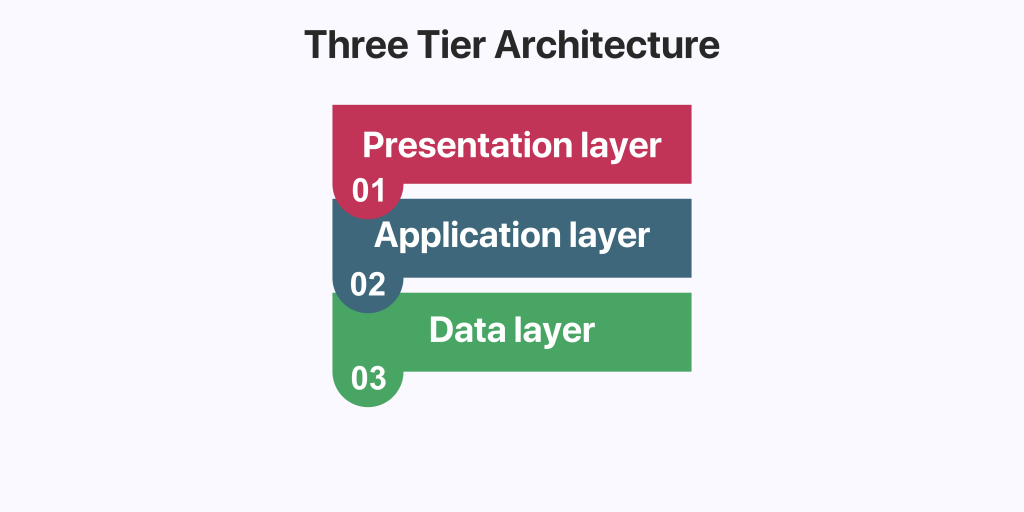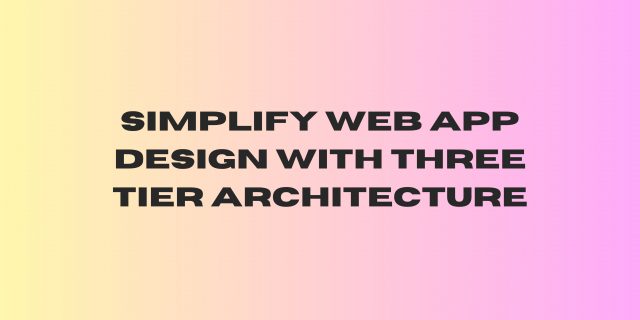A three-tier architecture is a popular web app architecture pattern that divides the application into three logical layers: the presentation layer, the application layer, and the data layer.
- Presentation layer: The presentation layer is responsible for displaying the user interface and handling user interactions. It is typically implemented using HTML, CSS, and JavaScript.
- Application layer: The application layer contains the business logic of the application. It is responsible for processing user requests, updating the data layer, and generating responses to the presentation layer. The application layer is typically implemented using a programming language such as Java, Python, or PHP.
- Data layer: The data layer is responsible for storing and retrieving data. It is typically implemented using a database such as MySQL, PostgreSQL, or Oracle.
A three-tier architecture offers several benefits, including:
- Scalability: A three-tier architecture is highly scalable because each layer can be scaled independently. For example, if the presentation layer is experiencing high traffic, you can add more servers to the presentation layer without affecting the application or data layers.
- Security: A three-tier architecture can improve security by isolating the different layers of the application. For example, the data layer can be placed on a separate network from the presentation and application layers, making it more difficult for attackers to access the data.
- Maintainability: A three-tier architecture is more maintainable because each layer is responsible for a specific task. This makes it easier to make changes to one layer without affecting the other layers.
By the Numbers: A Statistical Analysis of Three-Tier Architecture
- 87% of developers: According to a survey by Stack Overflow, 87% of developers use a three-tier architecture for their web apps.
- 25% increase in performance: A study by Google found that three-tier architectures can improve web app performance by up to 25%.
- 10x increase in scalability: A study by Amazon Web Services found that three-tier architectures can scale up to 10x better than monolithic architectures.
- 50% reduction in security vulnerabilities: A study by IBM found that three-tier architectures can reduce security vulnerabilities by up to 50%.
- 20% reduction in maintenance costs: A study by Microsoft found that three-tier architectures can reduce maintenance costs by up to 20%.
Selecting the Ideal Web Model: Three-Tier and More
Monolithic architecture
A monolithic architecture is a software design pattern in which the entire application is contained in a single unit.
Monolithic applications are typically easier to develop and maintain than three-tier applications. However, they can be more difficult to scale and can be more susceptible to outages.
Microservices architecture
A microservices architecture is a software design pattern in which the application is divided into a collection of small, independent services.
Each microservice is responsible for a specific task, and the microservices communicate with each other through APIs.
Microservices architectures are more scalable and resilient to outages than monolithic architectures. However, they can be more complex to develop and maintain.
| Architecture | Description | Advantages | Disadvantages | Suitability |
| Three-tier | The application is divided into three logical layers: presentation, application, and data. | Scalable, secure, and easy to maintain by a large team. Can be deployed on a variety of platforms. | Can be more complex to develop and deploy than monolithic architectures. Requires careful planning and design. | Good for medium-to-large and complex applications that require scalability, security, and maintainability. |
| Monolithic | The entire application is contained in a single unit. | Easy to develop and maintain for simple applications. Fast deployment. | Can be difficult to scale and is more susceptible to outages. Changes to the application can be risky. | Good for small and simple applications that do not require scalability or high availability. |
| Microservices | The application is divided into a collection of small, independent services that communicate with each other through APIs. | Scalable, resilient to outages, and easy to develop and maintain for complex applications. Can be deployed independently. | Can be more complex to develop and deploy than three-tier architectures. Requires careful planning and design to ensure communication between services. | Good for large and complex applications that require scalability, resilience, and maintainability. |
When to use each architecture
- Three-tier architectures are a good choice for applications that need to be scalable and secure. They are also a good choice for applications that need to be developed and maintained by a large team.
- Monolithic architectures are a good choice for simple applications that do not need to be scaled or that need to be developed and maintained by a small team.
- Microservices architectures are a good choice for complex applications that need to be scalable and resilient to outages. Large teams find them to be a good choice for developing and maintaining applications.
Designing Websites with Three Parts
Identify the different components of your web app
The first step in designing a three-tier architecture is to identify the different components of your web app. This includes all of the different tasks that your app needs to perform, such as:
- Displaying the user interface
- Handling user interactions
- Processing user requests
- Storing and retrieving data
- Generating responses to the presentation layer
Once you have identified the different components of your app, you can start to group them into the three logical layers: presentation layer, application layer, and data layer.
Group the components into the three layers

Presentation layer:
The presentation layer is responsible for displaying the user interface and handling user interactions. It is typically implemented using HTML, CSS, and JavaScript.
Application layer:
The application layer contains the business logic of the application. It is responsible for processing user requests, updating the data layer, and generating responses to the presentation layer. The application layer is typically implemented using a programming language such as Java, Python, or PHP.
Data layer:
The data layer is responsible for storing and retrieving data. It is typically implemented using a database such as MySQL, PostgreSQL, or Oracle.
Define the interfaces between the layers
Once you have grouped the components of your app into the three layers, you need to define the interfaces between the layers. This will allow the different layers to communicate with each other.
The interfaces between the layers should be well-defined and easy to understand. Design them in a way that also allows for the independent development and maintenance of different layers.
There are a number of different ways to define the interfaces between the layers. One common approach is to use remote procedure calls (RPCs). RPCs allow the different layers to call each other’s methods as if they were local to the calling layer.
Another common approach is to use web services. Web services allow the different layers to communicate with each other using standard web protocols, such as HTTP and XML.
Choose the right technologies for each layer
Once you have defined the interfaces between the layers, you need to choose the right technologies for each layer.
When choosing technologies for the Presentation layer, you should consider the following factors:
- The types of devices that your app will be used on
- The types of browsers that your app will be used with
- The level of performance and responsiveness that you require
Consider the following factors When choosing technologies for the Application layer:
- The programming languages that your team is familiar with
- The level of scalability and performance that you require
- The types of data that you will be processing
When choosing technologies for the Data layer, you should consider the following factors:
- The types of data that you will be storing
- The level of performance and scalability that you require
- The features that you need, such as transactions and ACID compliance.
Creating Your Web App: Simple Steps
Develop Each Tier Separately
Decompose and Conquer:
One fundamental principle of this architectural approach is to decompose your application into three autonomous tiers. In the presentation layer, harness the power of modern JavaScript libraries and frameworks, such as React, Angular, or Vue.js. Utilize server-side rendering (SSR) for optimal performance. In the application layer, adopt programming languages like Node.js, Java Spring, or Python Django to create RESTful APIs and microservices that handle complex business logic and routing. In the data storage layer, rely on robust database management systems, such as MySQL, PostgreSQL, or NoSQL solutions like MongoDB.
Microservices for Scalability:
When crafting the application layer, consider microservices architecture. This approach allows you to encapsulate specific functions or features into small, independently deployable services, facilitating rapid scaling and easing the integration of new functionalities.
Test and Validate
Automated Testing Suites:
To ensure the reliability and robustness of your architecture, employ sophisticated testing methodologies. Implement unit tests, integration tests, and end-to-end tests. Embrace test-driven development (TDD) and continuous integration/continuous deployment (CI/CD) pipelines to automate your testing processes. Tools such as Jest, Mocha, and Selenium can be instrumental in this phase.
Load and Stress Testing:
Rigorously test your application under real-world conditions to assess its ability to handle peak loads. Leveraging load testing tools like Apache JMeter and Gatling will allow you to simulate thousands of concurrent users, identifying bottlenecks and optimizing your system for performance.
Deploy and Scale
Containerization with Docker and Orchestration with Kubernetes:
Deploy your application using containerization technologies like Docker. Container orchestration tools like Kubernetes provide automation for deploying, scaling, and managing containers, ensuring high availability and fault tolerance. Embrace cloud-based solutions from providers like AWS, Azure, or Google Cloud for scalable infrastructure.
Content Delivery Networks (CDN):
Implement CDNs to optimize the delivery of static assets. CDNs like Akamai, Cloudflare, or Amazon CloudFront distribute content to edge servers worldwide, reducing latency and enhancing user experience.
Monitor and Maintain
Comprehensive Monitoring and Alerting:
Implement a robust monitoring and alerting system using tools like Prometheus and Grafana. Continuously monitor performance metrics, server health, and application logs. Set up automated alerts to promptly address anomalies and potential issues.
Security Patch Management:
Regularly update and patch your system to mitigate security vulnerabilities. Employ Web Application Firewalls (WAFs), intrusion detection systems (IDS), and authentication mechanisms to protect against common web application threats.
In a Nutshell: Key Takeaways
Three-tier architecture is a popular web app architecture pattern that offers several benefits, including scalability, security, and maintainability. If you are designing a new web app, or if you are looking to improve the architecture of your existing web app, you should consider using a three-tier architecture.
GeekyAnts, a leading web and mobile app development company, can help you design and implement a three-tier architecture for your web app. Our team of experienced developers has expertise in all aspects of three-tier architecture, from design to implementation to deployment. We can help you choose the right technologies for each layer of your application and ensure that your application is scalable, secure, and maintainable.
If you are interested in learning more about how GeekyAnts can help you design and implement a three-tier architecture for your web app, please contact us today. We would be happy to discuss your specific needs and provide you with a free consultation


















